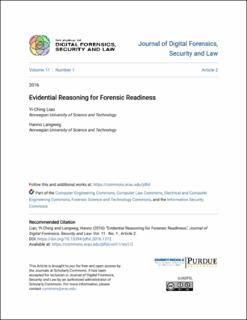| dc.contributor.author | Liao, Yi-Ching | |
| dc.contributor.author | Langweg, Hanno | |
| dc.date.accessioned | 2020-06-09T11:40:05Z | |
| dc.date.available | 2020-06-09T11:40:05Z | |
| dc.date.created | 2016-09-30T09:47:18Z | |
| dc.date.issued | 2016 | |
| dc.identifier.citation | The Journal of Digital Forensics, Security and Law. 2016, 11 (1), 37-52. | en_US |
| dc.identifier.issn | 1558-7215 | |
| dc.identifier.uri | https://hdl.handle.net/11250/2657357 | |
| dc.description.abstract | To learn from the past, we analyse 1,088 "computer as a target" judgements for evidential reasoning by extracting four case elements: decision, intent, fact, and evidence. Analysing the decision element is essential for studying the scale of sentence severity for cross-jurisdictional comparisons. Examining the intent element can facilitate future risk assessment. Analysing the fact element can enhance an organization's capability of analysing criminal activities for future offender profiling. Examining the evidence used against a defendant from previous judgements can facilitate the preparation of evidence for upcoming legal disclosure. Follow the concepts of argumentation diagrams, we develop an automatic judgement summarizing system to enhance the accessibility of judgements and avoid repeating past mistakes. Inspired by the feasibility of extracting legal knowledge for argument construction and employing grounds of inadmissibility for probability assessment, we conduct evidential reasoning of kernel traces for forensic readiness. We integrate the narrative methods from attack graphs/languages for preventing confirmation bias, the argumentative methods from argumentation diagrams for constructing legal arguments, and the probabilistic methods from Bayesian networks for comparing hypotheses. | en_US |
| dc.language.iso | eng | en_US |
| dc.publisher | Association of Digital Forensics, Security and Law | en_US |
| dc.relation.uri | http://ojs.jdfsl.org/index.php/jdfsl/article/view/372/265 | |
| dc.rights | Navngivelse 4.0 Internasjonal | * |
| dc.rights.uri | http://creativecommons.org/licenses/by/4.0/deed.no | * |
| dc.title | Evidential Reasoning for Forensic Readiness | en_US |
| dc.type | Peer reviewed | en_US |
| dc.type | Journal article | en_US |
| dc.description.version | publishedVersion | en_US |
| dc.source.pagenumber | 37-52 | en_US |
| dc.source.volume | 11 | en_US |
| dc.source.journal | The Journal of Digital Forensics, Security and Law | en_US |
| dc.source.issue | 1 | en_US |
| dc.identifier.doi | 10.15394/jdfsl.2016.1372 | |
| dc.identifier.cristin | 1387962 | |
| dc.description.localcode | This Article is brought to you for free and open access by the Journals at Scholarly Commons. It has been accepted for inclusion in Journal of Digital Forensics, Security and Law by an authorized administrator of Scholarly Commons. For more information, please contact commons@erau.edu. This work is licensed under a Creative Commons Attribution-NonCommercial 4.0 International License | en_US |
| cristin.ispublished | true | |
| cristin.fulltext | original | |
| cristin.qualitycode | 1 | |

